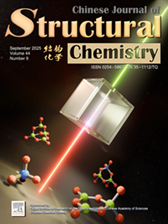
Cover Picture
Borosilicates as deep-ultraviolet transparent nonlinear optical crystals: structural motifs, performance limits and future directions
Yangfeifei Ou, Xiao-Liang Zhou, You-Zhao Lan, Jian-Wen Cheng* Submit a Manuscript
Borosilicates as deep-ultraviolet transparent nonlinear optical crystals: structural motifs, performance limits and future directions
Yangfeifei Ou, Xiao-Liang Zhou, You-Zhao Lan, Jian-Wen Cheng* Submit a Manuscript
Dynamic tuning of d-p orbital hybridization during sulfur vacancy evolution in Co9S8 toward efficient overall water splitting
Weilong Liu, Jipeng Dong, Luyao Zhang, Ning Li, Yangqin Gao, Lei Ge*
Chin. J. Struct. Chem., 2025, 44(9), 100661. DOI: 10.1016/j.cjsc.2025.100661
September 1, 2025
d-band center; Overall water splitting; Sulfur vacancy evolution; d-p hybridization
ABSTRACT
Defect engineering significantly enhances electrocatalytic performance by modulating electronic structures and interfacial coordination, yet the dynamic correlation between defect evolution and catalytic activity during reactions remains unclear. Herein, DFT calculations first revealed the modulation of sulfur vacancy concentrations on Co9S8 electronic structures, predicting that optimized vacancy concentrations enabled highly efficient electrocatalytic water splitting. Experimentally fabricated Co9S8 with appropriate sulfur vacancies exhibited superior bifunctional activity (HER: 164 mV@η10; OER: 297 mV@η100). The MCS-assembled overall water splitting system demonstrated stable operation at 1.57 V (10 mA cm-2) for over 24 hours. Experimental studies illustrated that sulfur vacancies preferentially adsorbed OH- during reactions, inducing the formation of CoOOH active phases. DFT analysis further indicated that OH- adsorption weakened d-p orbital hybridization, optimizing hydrogen/oxygen intermediate adsorption energy barriers and ultimately enhancing catalytic performance. This work establishes novel paradigms for systematic development of catalysts through synergistic analysis of defect dynamics, electronic structures and catalytic performance.







